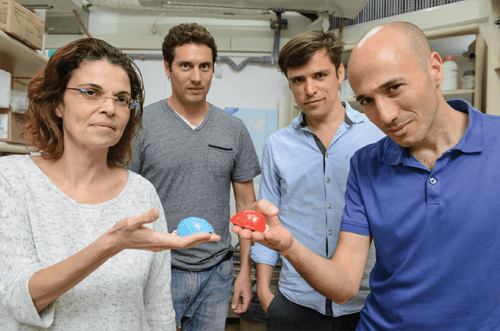The scientists of the institute discovered that in the area that supervises parental behavior in the brains of mice, there are more nerve cells that produce the TH enzyme compared to males, and also that mother mice have more such cells compared to females that have not yet given birth. Controlling the output rate of the hormone, by various means, changes the parental behavior in both males and females

Most female mammals give birth or give birth to their offspring and care for them, while males play a lesser parental role, and sometimes even switch to other females shortly after mating (a behavior known as polygamy). And yet, scientists find it difficult to pinpoint the exact area in the brain where these differences between the sexes manifest, or arise from. Because of this, the question to what extent "parental behavior" is burned into the structure of the brain has so far remained open.
Dr. Tali Kimchi and research student Niv Scott, in collaboration with Dr. Ofer Yizhar and postdoctoral researcher Dr. Mathias Friga, from the Department of Neurobiology at the Weizmann Institute of Science, set out to find a solution to this basic question, and focused on laboratory mice. Mice tend to behave quite maternally even if they have not yet given birth to pups. They will return a puppy that was left in the corner of the cage to the safe place in the breeding nest, devote time to the care of a day-old puppy, and more. This tendency is amplified in mice that are mothers. The males, on the other hand, are usually aggressive and guard their territory. In many cases they ignore residences that are not theirs, and sometimes even attack them. But for a short period of time after mating and giving birth, they still exhibit parental behavior.
To investigate how the brain controls this parental behavior - in both males and females - the scientists focused on a small part of the brain located in the hypothalamus and called the AVPV. This part is larger in females than in males, and especially in females it has more nerve cells that express the protein Tyrosine Hydroxylase (TH), which plays a role in the production of the neurotransmitter dopamine. Thus, it was found that mice have more TH-producing nerve cells compared to males, and that mother mice have more such cells compared to females that have not yet given birth.
The scientists used genetic and neuro-biochemical methods - among other things through light stimulation (opto-genetic) - to increase and decrease the expression of TH in the neurons of the defined brain area, as well as to activate this group of neurons, and recorded the resulting behavioral effects - both in both males and females. In this way, it became clear that increasing TH levels in these nerve cells particularly affects the maternal behavior of the mice. Brief optogenetic stimulation of the TH-secreting neurons caused a significant increase in maternal behavior. In a follow-up experiment, it became clear that these manipulations also increased the levels of oxytocin (a hormone that helps contract the uterine muscles during childbirth as well as breastfeeding, and is referred to as the "love hormone") in the blood, which was manifested in more devoted parental behavior. Conversely, reducing the number of TH-expressing neurons in mice resulted in lower oxytocin levels, and the disruption of their parental behavior.
On the other hand, using optogenetic methods (activating neurons with light) to increase the activity of TH-secreting cells in male mice did not lead to a change in oxytocin levels and treatment of pups, but, surprisingly, greatly reduced the aggressive behavior of non-father males towards foreign pups , as well as towards foreign adult males. Reducing the number of these neurons resulted in an increase in aggression towards puppies, and a significant increase in aggression in general. That is, this group of nerve cells is apparently responsible for reducing aggressive behavior in males (differently than in females).
"Controlling the activity and quantity of these unique nerve cells allowed us to direct the degree of maternal behavior of the females, as well as the aggression of the males," says Dr. Kimchi. "The results of the study imply that maternal behavior is controlled by innate nerve cell networks, which differ to some extent in males compared to females, and which are controlled, at least partially, by the hormone oxytocin."
Dr. Tali Kimchi and the members of her research group intend to continue investigating the networks of nerve cells in the brain that regulate parental behavior, alongside other behaviors that differ between males and females, such as social communication, aggression and sexual behaviors. In this way, they hope to better understand the relationship between innate brain traits (genetic, physiological and structural) and environmental influences to which we are exposed during life, as well as to find an answer to the question of how all these shape social behavior in males and females. These insights may, in the future, help to understand the biological factors involved in brain disorders of a social nature, which manifest themselves in different ways in men and women, such as postpartum depression, aggression and autism.
In the mothers' brains, in a subregion in the hypothalamus, there are about 50% more neurons that produce dopamine that control parental behavior, compared to the number of these cells in females who are not mothers.
